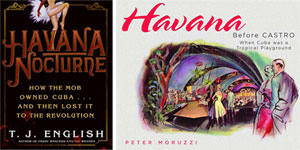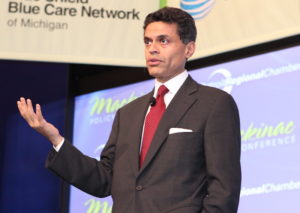Rosa Lowinger on Cuba Before Castro
Two new books resurrect the seductions and corruptions of pre-revolutionary Cuba.
This New Year’s Eve will mark the half-century anniversary of a night when Cuban dictator Fulgencio Batista, in anticipation of Fidel Castro’s advancing revolutionary army, abandoned the island he had ruled on and off for nearly 25 years. For Cubans over a certain age, it was a where-were-you-when-Kennedy-was-assassinated kind of moment, remembered with intensity and vivid detail. My parents, for example, recall that they were partying at a neighbor’s apartment in Vedado, a middle-class Havana neighborhood. They had stayed home instead of going to the Tropicana cabaret—their usual New Year’s Eve activity—because they had heard rumors that nightclubs, which had been bombed repeatedly in the preceding years, were going to be sabotaged. My folks were weary of the war and hoping that Batista would finally step down, but like any good Cuban they nonetheless spent New Year’s Eve dancing, drinking rum and eating with friends. Sometime after midnight, they saw a military airplane fly low overhead, then bank to the right over the Straits of Florida. At the time, they did not know that the plane was carrying Batista and his family. The next morning, the evidence was everywhere: Mobs were racing down the streets of Havana, ripping up the parking meters and trashing casino gaming rooms. People were waving flags and shouting “Viva Fidel, down with Batista.” The Castro years had officially begun.
In the ensuing five decades, as neither Cuba’s government nor U.S. policies toward Cuba have substantively changed, several dozen books in English and Spanish and thousands of pages of newspaper and magazine articles have been devoted to the subject of that night and the decades that preceded it. It is no wonder. Not only is the stalemate between our two countries endlessly interesting, if not frustrating, Cuba of the epoch was a dazzling setting for political calamity. Fueled by a thriving economy that failed to trickle down to the nation’s poorest people, 1950s Cuba was in the throes of an artistic boom that was unparalleled in the island’s history. The nation’s legendary musicians, having already influenced world music with rhumba and Latin jazz, came up with the electrifying mambo and cha-cha-cha. The nation’s architects were at the vanguard of midcentury Modernism. Havana was the gambling capitol of the Western Hemisphere—a title that Las Vegas would inherit after the revolution—and this produced a cabaret scene that featured a stew of stunning showgirls, glittering costumes, steamy underground sexuality and American mobsters who enriched themselves and their corrupt political associates beyond imagination.
Havana Nocturne
By T.J. English
William Morrow, 416 pages
Havana Before Castro
By Peter Moruzzi
Gibbs Smith, 256 pages
In recent months, two notable nonfiction titles have been published about Cuba of that era: T.J. English’s “Havana Nocturne: How the Mob Owned Cuba Then Lost It to the Revolution” and Peter Moruzzi’s “Havana Before Castro: When Cuba Was a Tropical Playground.” [Editor’s note: To read parts of “Havana Nocturne,” click here.] English paints the complex portrait of the American mob’s near-control of Cuban gambling. Best known for his books on Irish and Asian gangs in New York, English uses his profound understanding of organized crime to tell a compelling story of greed and influence in which the Cuban government, led by dictator Batista, worked hand in glove with mobsters such as Meyer Lansky. Their dream, which English explains was to turn Cuba into “a criminal state whose gross national product … would become the means to launch further criminal activities around the globe,” was thwarted by the Cuban revolution. In English’s account the drama of those events is framed not as the traditional clash between Batista and Castro, but between Castro and Lansky.
Anyone who’s seen Francis Ford Coppola’s “The Godfather,” based on Mario Puzo’s novel, or read biographical material on Lansky, Charles “Lucky” Luciano or other mobsters of the era, knows the basic story line of this book: The mob ran the large 1950s Havana casinos that catered to the tourist population, and those activities were a large part of the mob’s revenues during the period. The reason is simple enough: Gambling was legal in Cuba and illegal in the United States. Gamblers, considered criminals in the United States, could set up as legitimate businessmen in Cuba and continue to engage in all manner of legal and illegal enterprises. All they had to do was pay proper homage, i.e. exorbitant bribes, to Batista and members of his government. Cuba’s gambling industry was not founded by the mob, nor was the culture of freewheeling sexuality that accompanied the casino-tourist trade a product of the mob. Indeed, the most opulent and famous of the casino-cabarets, Tropicana, was owned by a Cuban. Nonetheless, the close associations of all the gamblers operating in Cuba, including Tropicana’s owner, with the oppressive ruling dictatorship was viewed by the revolutionaries and many ordinary Cubans as a symbol of all that was wrong with Cuba during the Batista era. As a result, once Castro took power the casinos were shut down and the gamblers ousted.
English’s assemblage of the material follows this traditional line of understanding, but his account contains much new material, including detailed interviews with men like Armando Jaime Casielles, Lansky’s former driver—to whom, not incidentally, he dedicates this book — and Bernard Frank, Lansky’s former lawyer. English is also a great raconteur, and the pitting of Lansky against Castro is storytelling at its finest. For what could be a more compelling, cinematic vision of the Cuban drama than to line up adversaries of such urgent motivation as Castro and Lansky? Set up side by side as in English’s book, the two come off as brilliant men with giant dreams and hubris to match. Their inevitable clash, which has the cathartic quality of Shakespearean or Greek drama, is also peppered throughout with delectable tidbits, like stories about Lansky’s stunning Cuban mistress, John F. Kennedy’s Havana tryst with three prostitutes, and Cuban sex star Superman’s prodigious manhood. Yet, as enjoyable and well researched as this book is, and as much as its author expresses clear empathy for the island that is at the center of his drama (he also dedicates the book to “the Cuban people”), it is sometimes an uncomfortable read for a Cuban. Admittedly, this is partly a function of having one’s story told by an outsider. Nearly every Cuban story has a political slant, and Cubans like myself who are neither Fidelistas nor supporters of the U.S. embargo of Cuba are always alert to nuances that would suggest, on the one hand, that Cuba before Castro was a cesspool and we got what was coming, or, on the other hand, that Cuba before Castro was a paradise. English takes great pains not to put forth either extreme; however, the story line implies that our country’s political upheaval was the fault of outside forces, i.e. the American mob, and not a function of our own willingness to turn a blind eye to our leaders’ rapaciousness and mendacity. Framed thusly, Cuba of the 1950s appears as the prototypical damsel in distress, bound up on the train tracks and waiting for a rescuer, in this case Fidel Castro. English’s description of the ribald cornucopia that was Havana in the 1950s as “the sexual degradation of Cuban citizens for the entertainment of North American and European tourists” might seem to support this point of view, but it also reveals an outsider’s view of the socio-sexual complexities of Cuba. After all, Cuba is a country where, in early 1998, when the Clinton-Lewinski scandal broke, I was not only asked repeatedly by both men and women “what the big deal was,” but was told outright that Americans should have been more suspicious of a president who did not take advantage of an intern’s sexual offering. Sex was and is an easy commodity in Cuba, as it is in Las Vegas, as it is on the Internet, as it is in many people’s minds. In Cuba, however, it has always been more or less out in the open. And whether or not one considers it demeaning for women and men to sell their bodies is beside the point. The fact is that the revolution did nothing to change that attitude. Cuba continues to be a place where planeloads of male tourists arrive from Europe to meet young women for sex. Only now these women are not “declared” prostitutes. They’re students, nurses and Tropicana dancers who are desperately looking to hook up with a foreigner who will get them out of the country.
The idea of Cuba as this loose, licentious broad who needed to be whipped back into shape by revolution is a more overt subtext of Peter Moruzzi’s “Havana Before Castro: When Cuba Was a Tropical Playground.” Though it’s hard for a Cuban not to bristle at the implications in the subtitle, this is a visually delightful volume, beautifully laid out and abundant in annotated photographs and memorabilia. Some of this material, particularly the memorabilia, has appeared in previous sources, most notably Steven Heller and Vicki Gold Levi’s “Cuba Style”; however, Moruzzi, who is an architectural historian by training, does a laudable job with sections on Modernist architecture, particularly his innovative “then and now” pairings of images of buildings from the present and past. The text is fairly elementary, but the images—which include such little-seen jewels as the calling cards from Tia Nena’s bordello and period photographs of the Caribe Suite at the Havana Hilton—provide a rich visual narrative about Cuba before the revolution as it would have been perceived by a visiting American. Moruzzi, who has been to Cuba only once, makes no bones about this point of view. Yet some sections demonstrate an irksome paternalistic outlook toward the behavior of Cubans in the 1950s. In one chapter, titled “Life as a Habanero,” Moruzzi states, “While Cuban politics roiled in the background (and sometimes in the foreground) Habaneros went on with living.” On the next page, an image of Cubans shopping in an appliance store is captioned “stoking the consumer culture in 1956,” as if an image of people buying washing machines is evidence that something is amiss with a society. It’s hard not to miss the moralizing implication of these statements, especially in light of a previous section, entitled “A Man on the Make,” where Moruzzi envisions a night on the town for a male tourist in the 1950s:
Havana Nocturne
By T.J. English
William Morrow, 416 pages
Havana Before Castro
By Peter Moruzzi
Gibbs Smith, 256 pages
“… [T]here are plenty of girls at the bar—a couple of them real lookers. … One of them, her name seems to be Juana or Wanda or something like that, is real friendly, sort of a Cuban Jane Mansfield. Not really. But she’s got nice curves and platinum blonde hair and she laughs a lot. Her English isn’t so great, but who cares? … You head out for the Sans Souci. … The show has lots of good-looking gals with plenty of thigh and pleasing backsides and knockers to boot. But you’re too busy with each other to pay much attention. … You wander over to the Club Room … and watch her jiggle as she wins on number thirty-three. …”
The author might think he’s doing a great literary turn with this hard-boiled Raymond Chandler-style ennui, but it’s clear to any reader, and certainly this Cuban woman, that this passage is laden with a throwback form of wishful thinking that is meant to be both titillating and disparaging. Taken together with the comments about capitalist consumption and the author’s obvious appreciation of the period’s artistic splendor, it paints a murky moral picture of Cuba as a delicious, naughty girl (wink, wink) who might have been spared years of Castroism and embargo if only she’d been less profligate. This story line makes for a nice narrative, but it fails to see us as we see ourselves—both then and now. And that is as a people that despite Spanish colonialism, American intervention, a half-century’s worth of kleptocratic oligarchies and another half-century of Stalin-style communism, still knows that sex is fundamental and New Year’s Eve is for partying.
Rosa Lowinger was born in Havana and grew up in Miami. She is the co-author (with Ofelia Fox) of “Tropicana Nights: The Life and Times of the Legendary Cuban Nightclub.”
Dig, Root, GrowThis year, we’re all on shaky ground, and the need for independent journalism has never been greater. A new administration is openly attacking free press — and the stakes couldn’t be higher.
Your support is more than a donation. It helps us dig deeper into hidden truths, root out corruption and misinformation, and grow an informed, resilient community.
Independent journalism like Truthdig doesn't just report the news — it helps cultivate a better future.
Your tax-deductible gift powers fearless reporting and uncompromising analysis. Together, we can protect democracy and expose the stories that must be told.
This spring, stand with our journalists.
Dig. Root. Grow. Cultivate a better future.
Donate today.










You need to be a supporter to comment.
There are currently no responses to this article.
Be the first to respond.